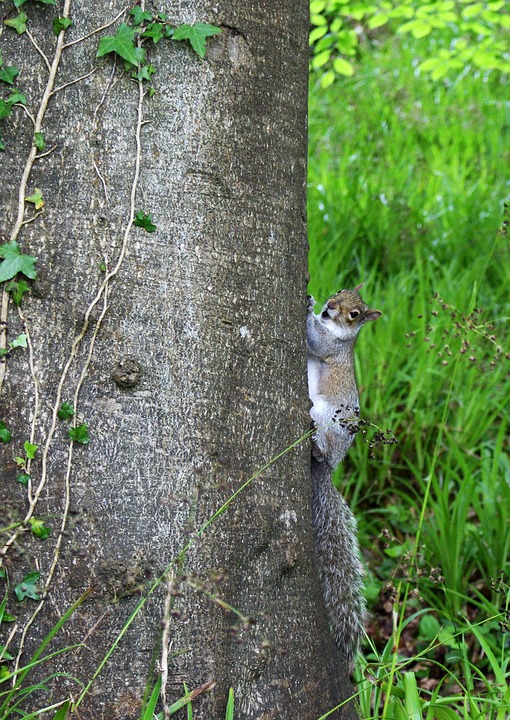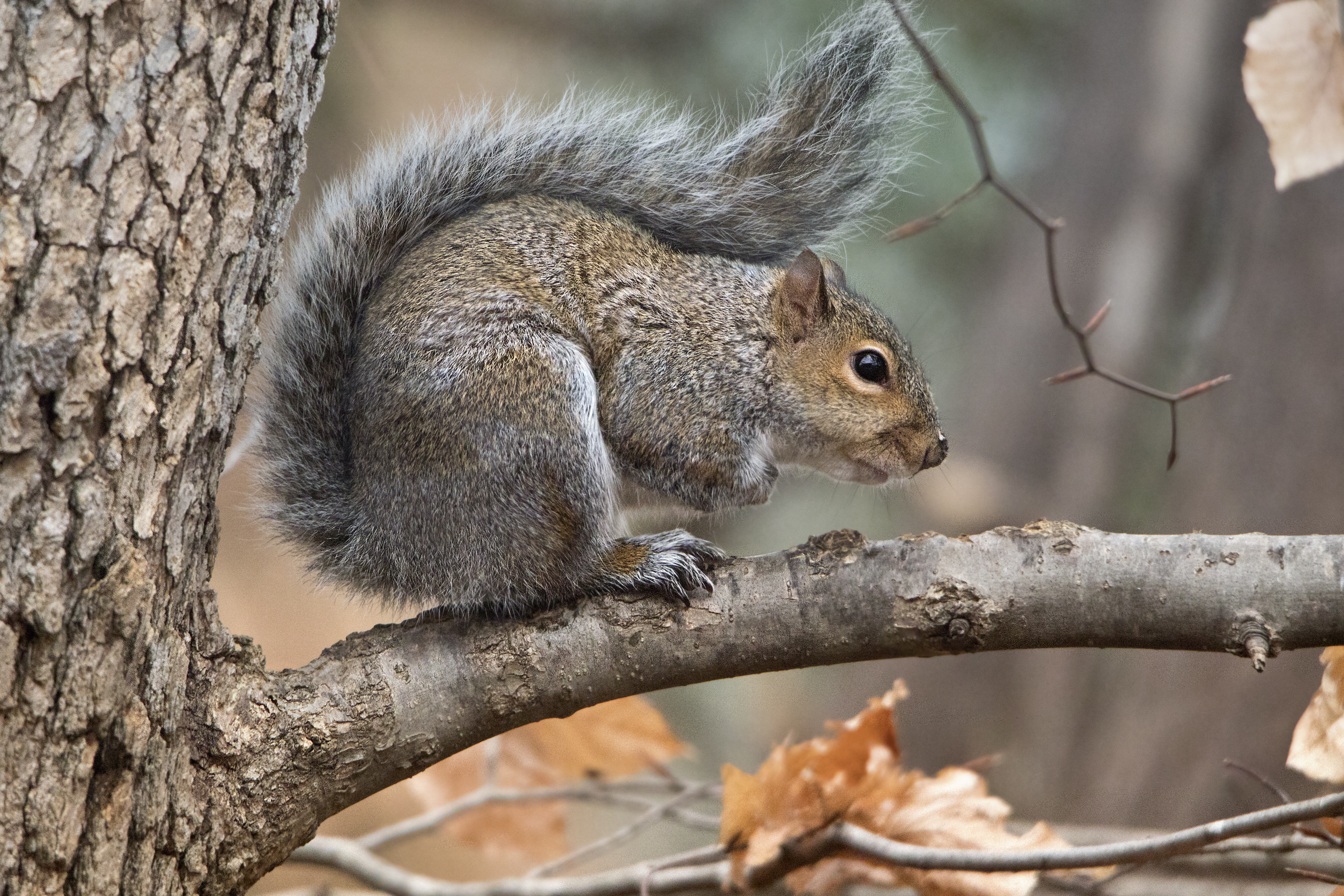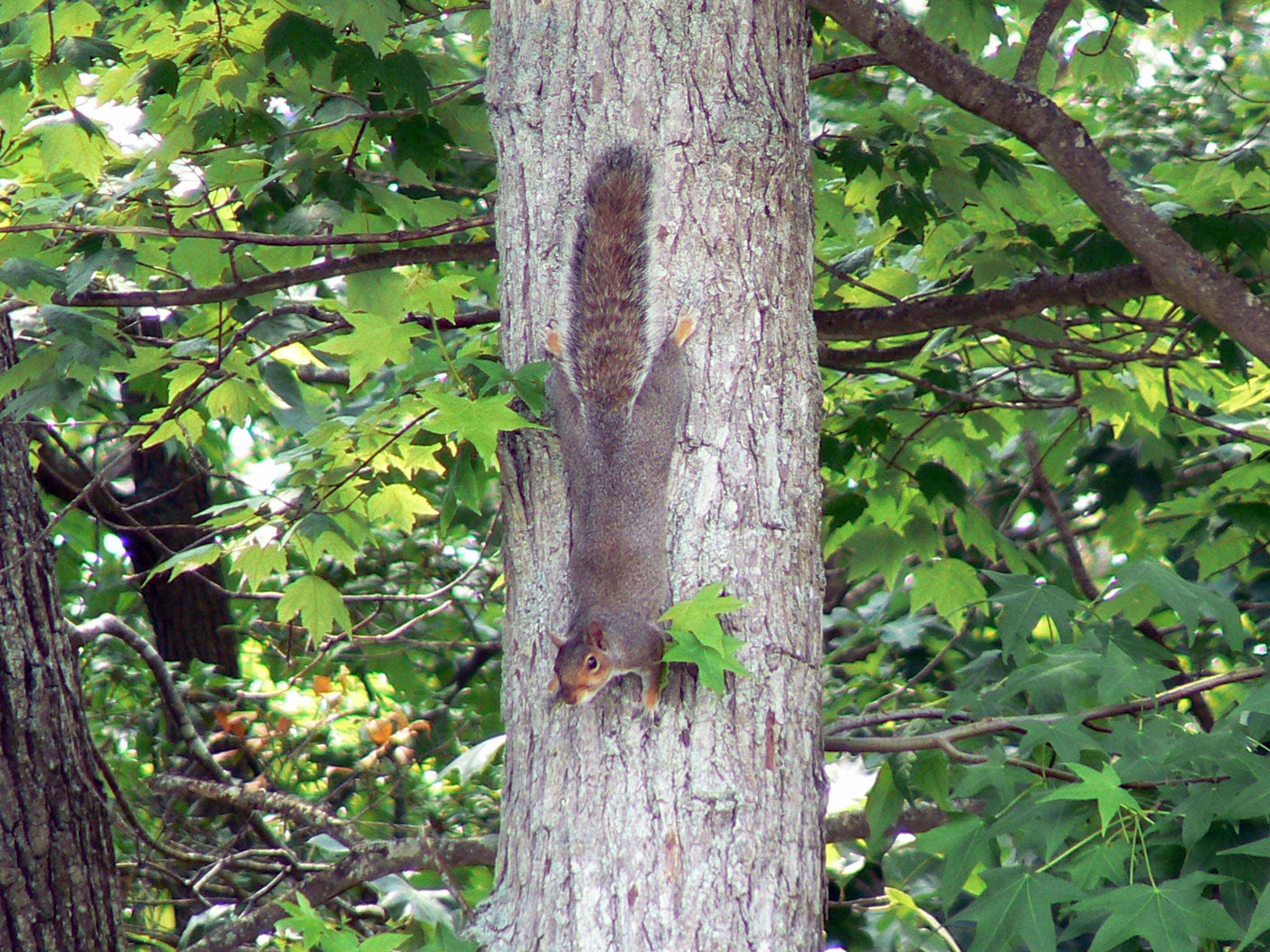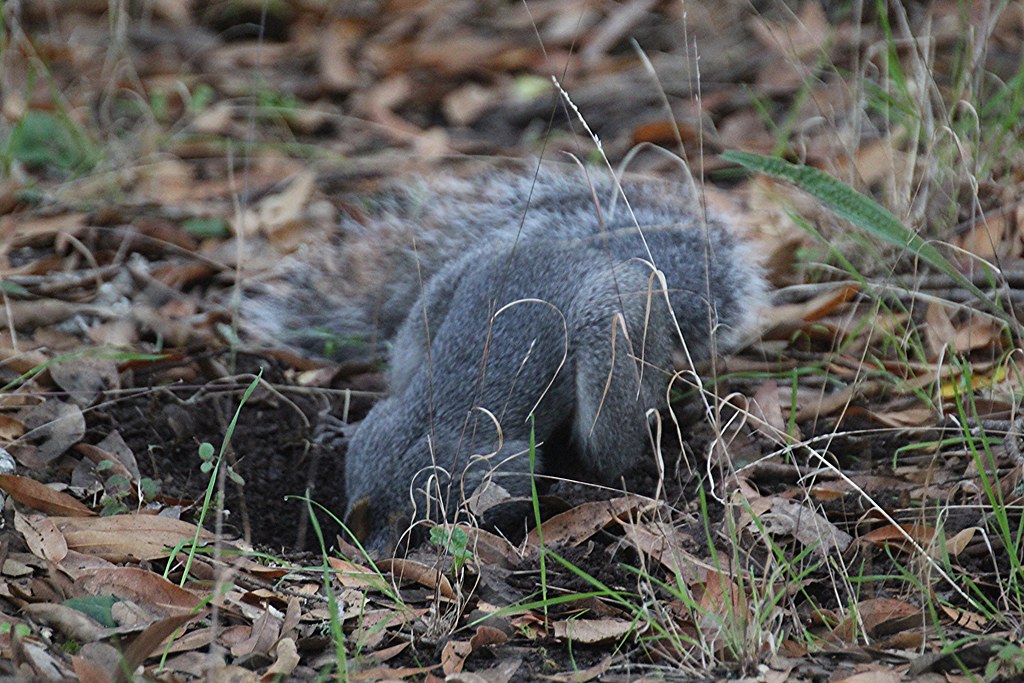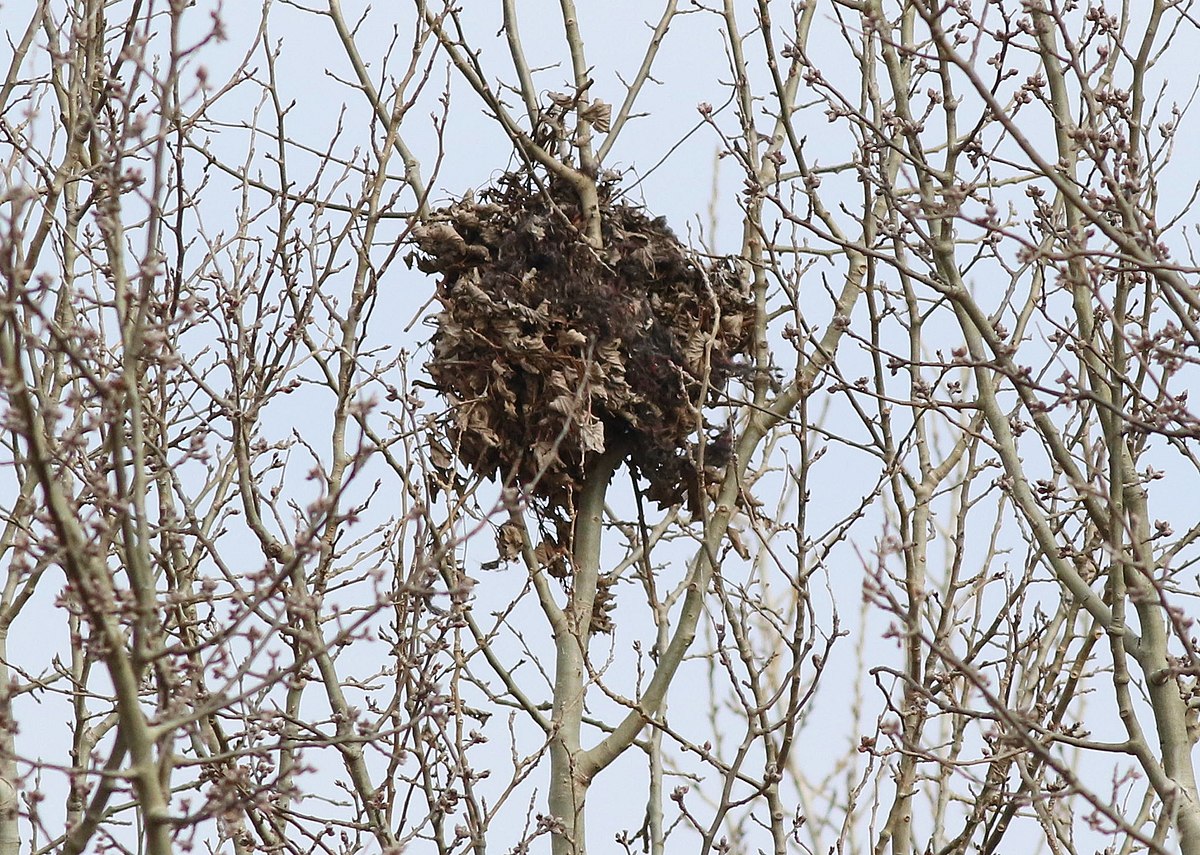Wonders of Wildlife: Eastern Gray Squirrel
Eastern Gray Squirrel
Other Common Names: Gray Squirrel, Cat Squirrel, Migratory Squirrel
Scientific Name: Sciurus carolinensis
Found in Alabama: Common statewide
Diet: Omnivore (eats plants and animals)
|
|
Eastern Gray Squirrel in Habitat
Pixabay - Lucy_Prior
Click image to enlarge it |
Learn more about...
| CLASSIFICATION |
|
What type of animal am I?
- I am a vertebrate (an animal with a spine or backbone).
- I am warm-blooded, so I can control my body temperature.
- I have hair/fur on the outside of my body that keep me warm.
- I breathe with lungs just like you.
- I have 4 legs.
|
Scientists use basic traits to group animals into different taxonomic classes.
For a taxonomic classification chart comparing key traits of common backyard wildlife,
CLICK HERE! |
|
| The Eastern Gray Squirrel is a MAMMAL! |
| IDENTIFICATION TIPS |
| |
|
|
Size: |
- Adults reach around 16-20 inches in length and weigh around 1-1.5 pounds.
|
Adult Eastern Gray Squirrel
Wikimedia - C. Watts
Click on image to enlarge it
|
| |
|
Key Characteristics: |
- Grey coloration on the back and ligher on the belly
- Bushy tails
- Each strand of hair has black, white, and red banding making them appear gray in coloration.
|
| |
|
|
Juveniles (young): |
- Young are similar in appearance to adults but are smaller in size.
|
| ADAPTATIONS |
| |
| PHYSICAL ADAPTATIONS |
| |
| Eastern Gray Squirrels forage in the trees: |
- Eastern gray squirrels are known to forage for seeds and other resources both in the trees and on the ground.
- They prefer to forage in the trees because they can more easily escape from predators (animals that eat them) or other threats.
- They have excellent balance and are quick when jumping from tree to tree.
- They can also turn their hind feet to face backward in order for them to easily climb down the tree head first.
|
Eastern Gray Squirrel Climbing Tree
Perlick Laura, U.S. Fish and Wildlife Service
Click on image to enlarge it
|
| |
| Eastern Gray Squirrels have heightened senses: |
- Eastern gray squirrels have several adaptations relating to their senses that help them survive.
- They have a heightened sense of smell that helps them food.
- Their sense of smell is also used to detect the stress levels of other eastern gray squirrels. This is helpful because it can help them determine if there is a threat in the area. If they detect higher levels of stress, it would indicate that there is a threat nearby.
- Their eyes are specialized for high levels of light and are tilted slightly upward. these traits are helpful for making it easier for them to spot a predator (animal that eats them) from above.
|
| |
| |
| BEHAVIORAL ADAPTATIONS |
| |
| Eastern Gray Squirrels are diurnal: |
- They are active during the day (diurnal).
|
| |
| Eastern Gray Squirrels store their food: |
Eastern Gray Squirrel Burying (Caching) Food
Flickr- Mark Gunn
Click on image to enlarge it
|
- Eastern gray squirrels are scatter hoarders, meaning they cache (store) food sources like nuts and seeds.
- Storing large amounts of food is beneficial to them because they do not hibernate.
- They must rely on the extra stored food to get through the colder months when a variety of food sources might be less available.
|
| |
| Eastern Gray Squirrels have seasonal behaviors: |
- Eastern gray squirrels change their behavior according to the season.
- During the warmer summer months, they are most active about 2 hours after sunrise and about 2 - 4 hours before sunset. This allows them to rest during the warmest hours of the day.
- During the winter, eastern gray squirrels are more active throughout the day.
|
| |
| LIFE CYCLE |
| |
|
|
| Life Cycle Stages of the Eastern Gray Squirrel |
| |
|
|
Nest: |
- Nests are made from sticks and leaves and are located high in trees.
|
Eastern Gray Squirrel Nest
Wikimedia - Mgr. Jozef Lengyel, PhD.
Click on image to enlarge it |
| |
|
Young: |
- Females give birth to 2-4 babies in each litter and can have two litters each year.
- Young are similar in appearance to adults but are smaller in size.
|
| |
|
|
| Life Span: |
- Average of 7 years but can potentially live up to 12.5 years.
|
| NATURAL Habitat Needs |
ADULTS |
YOUNG |
| Food |
- In summer months, they feed on plant buds, mushrooms, crops, and some insects. They also feed on fruits from wild cherry, dogwood, hawthorn, and gingko.
- In winter months, they feed on seeds from oaks, hickory, walnut, and pecan trees as well as other nuts and pinecones.
- They will also eat bird eggs and nestlings, frogs, and bones.
|
- The young feed on milk from the mother for the first 7-10 weeks after birth.
|
| Water |
- Majority of water is obtained through food sources, but they will drink from streams, ponds, puddles, and pools of standing water that collects in tree cavities.
|
- Obtain hydration from mother until independent.
|
| Shelter |
- They live in hardwood forests and mixed pine/hardwood forests.
- They will utilize natural cavities or old woodpecker holes for shelter.
|
- Nests in trees or cavities provides shelter for the young.
|
| Places to Raise Young |
- Females use natural cavities if they are available.
- Females build nests (called dreys) made of leaves and twigs. These placed relatively high in the forks of trees.
|
|
BACKYARD
Habitat Needs |
ADULTS |
YOUNG |
| Food |
- Plant grain producing plants (corn), seed producing trees (oak and walnut), and shrubs.
|
- Providing resources to support the parents will indirectly support the young because the young rely on the mother for milk.
|
| Water |
- If a natural water source is not located nearby, provide a bird bath or another form of standing water.
|
| Shelter |
- Do not remove mature trees.
- Plant shrubs and other greenery that would provide a hiding place.
|
| Places to Raise Young |
- Keep mature trees where they can build their nests (dreys).
- provide a nest box that can act as a cavity.
|
|
| ECOLOGICAL ROLE |
| |
|
| Animals play an important ecological role in the health of habitats and ecosystems. |
| |
|
|
Food Source:
|
- Eastern gray squirrels are eaten by other mammals including red foxes, coyotes, bobcats, and weasels.
- Birds of prey including red tailed hawks and owls as well as rattlesnakes also eat them.
|
| |
|
Seed Dispersal: |
- Eastern gray squirrels eat seeds from a variety of plants and cache (store) their food sources.
- This helps promote seed dispersal (movement to a new location) for those plant species.
|
INFORMATION SOURCES FOR THIS SPECIES
|
|
|
|
| |
|
|
|
|
|
|
| |
|
|
|
|
|
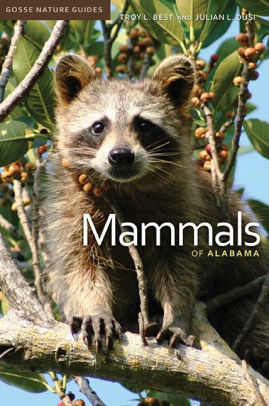 Best, T. L. and J. L. Dusi. 2014
Best, T. L. and J. L. Dusi. 2014
Mammals of Alabama
The University of Alabama Press
|
| |
|
|
|
|
|
|
|
|
|
|
.






 Wildlife Tag
Wildlife Tag
